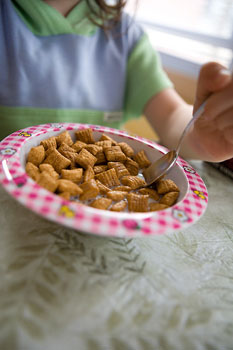 New research confirms what consumers have long known -- most breakfast cereals advertised to children are full of sugar.
New research confirms what consumers have long known -- most breakfast cereals advertised to children are full of sugar. Cereals marketed to kids have 85 percent more sugar, 65 percent less fiber and 60 percent more sodium than those aimed at adults. In fact, the least nutritious cereals are often the most heavily marketed to children, such as Reese's Puffs, Corn Pops, Lucky Charms, Cinnamon Toast Crunch and Cap' n Crunch.
Some cereals with the poorest ratings even have health claims on the box.
San Francisco City Attorney Dennis Herrera has written a letter to the CEO of Kellogg’s, demanding evidence that Cocoa Krispies really "helps support your child's immunity" as it purports to do on the front of the box.
Cocoa Krispies are 40 percent sugar by weight. A Kellogg's company spokesperson, Susanne Norwitz, argued that Kellogg's Krispies cereals provide consumers with 25 percent of their daily value of vitamins A, C, and E.
Kellogg began making the immunity claims about Cocoa Krispies in May, however as of November 4 said they’re pulling the claim from the box.
Meanwhile, the average preschooler sees 642 cereal ads a year on TV. Most are for types with the worst nutrition ratings.
According to Cereal FACTS (Food Advertising to Children and Teens Score), which was developed based on the best available science, in consultation with a steering committee of experts in nutrition, marketing, and public health, the 10 worst breakfast cereals based on nutrition score are:
- Kellogg - Corn Pops (or Pops) - Chocolate Peanut Butter
- Quaker - Cap'n Crunch - w/ Crunchberries
- Kellogg - Special K - Chocolatey Delight
- Kellogg - Special K - Blueberry
- General Mills - Reese's Puffs
- General Mills - Fiber One - Caramel Delight
- Kellogg - Cocoa Krispies - Choconilla
- General Mills - Golden Grahams
- General Mills - Cinnamon Toast Crunch
- Kellogg - Corn Pops
November 14 2009 | 47,196 views
Sources:



No comments:
Post a Comment